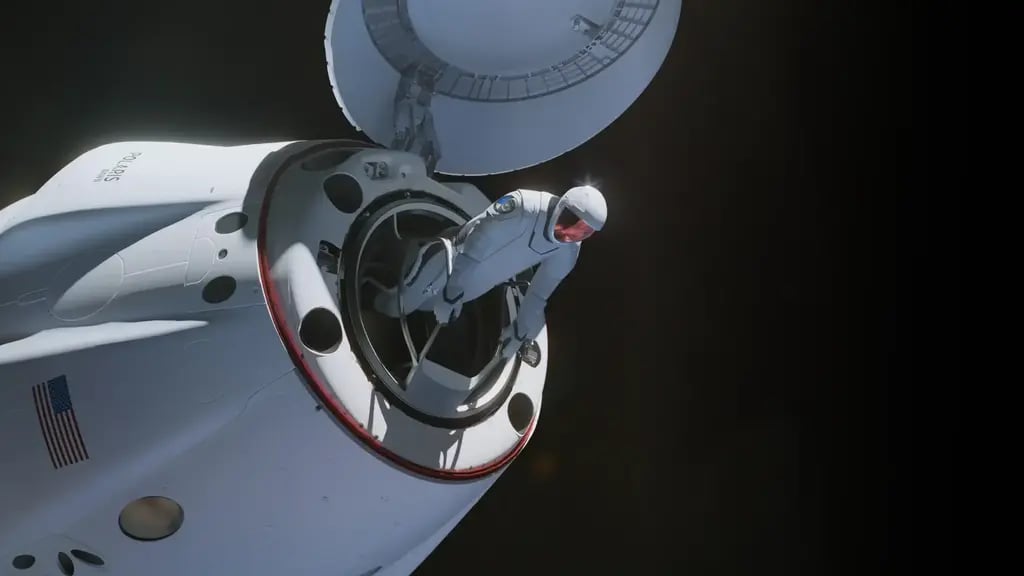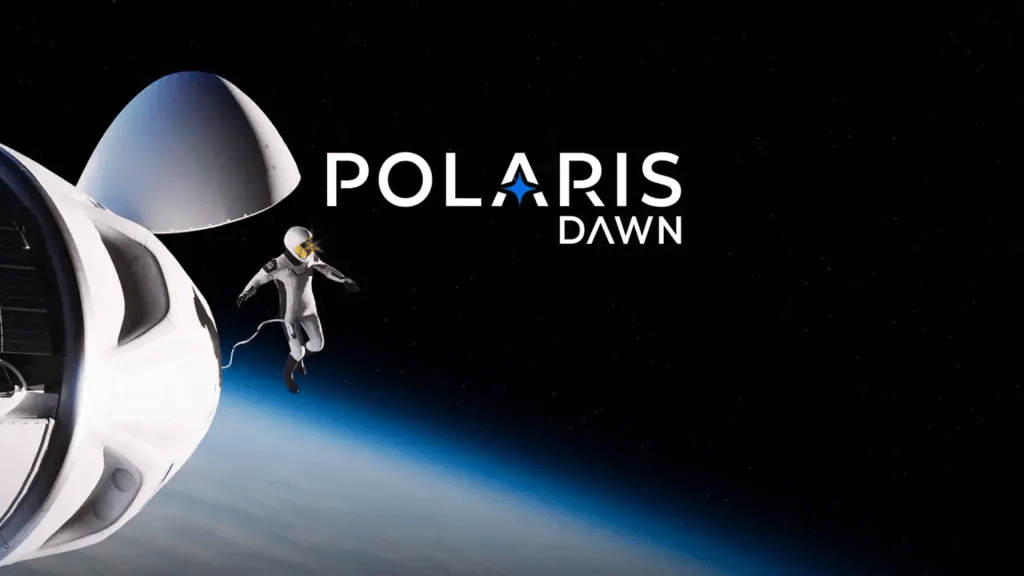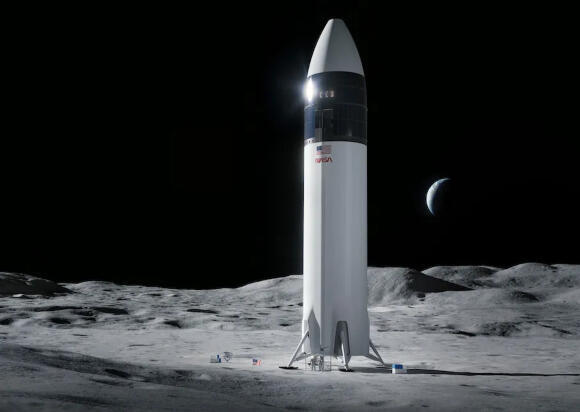Boundary-breaking private mission – this month?
The first private space mission in the "Polaris" (Polaris) program might launch as soon as this month. The program team announced in a brief tweet on social media platform X that they are " targeting no earlier than July 31 for the launch of Polaris Dawn” – indicating this as the planned launch date.
As of now, there has been no official confirmation from SpaceX or billionaire Jared Isaacman, who funds the program and is set to command the first of three planned missions.
Isaacman, who piloted the groundbreaking Inspiration 4 mission in 2021 - the first all-private astronaut space mission in history - funded by him - now aims to take the collaboration with SpaceX one step further, leading a series of pioneering private space missions. The first mission, Polaris 1, dubbed "Dawn," sets several ambitious goals.
Among other things, the crew is supposed to reach a distance of about 1,400 kilometers from Earth – a distance not reached by humans since the Apollo manned moon missions. Set to be positioned on the edge of the Van Allen belts, which shield Earth from radiation, one of the mission’s goals will be to assess astronaut exposure to radiation and its effects.
Subsequently, SpaceX's Dragon spacecraft is planned to stabilize in an orbit 700 kilometers high – significantly beyond typical human-operated regions. For comparison, the International Space Station orbits Earth at 400 kilometers, and the Hubble Space Telescope, visited by several astronaut crews over the years, floats at a height of 550 kilometers.
Another pioneering aspect of the mission is the plan for a "spacewalk" – an activity outside the spacecraft – performed for the first time by a private astronaut crew. During this venture, crew members will test SpaceX's new spacesuits designed for use both inside and outside the spacecraft.
These suits connect to the spacecraft's life support systems via tubes, eliminating the need for the astronauts to carry a separate independent system to survive in space, unlike the suits used for activities outside the International Space Station.
With the Dragon spacecraft lacking an airlock - a transition chamber for exit and entry - opening the hatch in space will necessitate all four crew members donning spacesuits and being exposed to vacuum space conditions. Two astronauts will venture outside while two remain inside the spacecraft. This will be the first instance in history where four crew members are exposed simultaneously to space conditions, surpassing the record of three set during the Apollo missions.
The crew is supposed to spend about five days in space, conducting 38 experiments and studies. Alongside Isaacman, who embarks on his second space journey, the crew includes Scott Poteet, a former US Air Force test pilot and Ironman triathlete; Sarah Gillis, an aeronautical engineer at SpaceX responsible for astronaut training; and Anna Menon, a biomedical engineer overseeing mission management at SpaceX, formerly part of NASA's ground control team for the International Space Station.
Technically, these are private astronauts, but in practice, this team has undergone training for the mission over several years, with backgrounds and experience in space, and training that matches that of professional astronauts, including centrifuge training to withstand strong G-forces.
The Polaris program seems poised to go down in history as another milestone in blurring the lines between an era when space was the domain of national agencies and a reality in which extensive and pioneering private sector activity is taking place outside Earth.
“We want to share lessons learned with everyone,” Poteet said in an interview on NASASpaceflight Live two years ago. “This is about allowing all of humanity to be involved, to get to the Moon, to get to Mars.”
Private astronauts with training similar to that of professional astronauts. The Polaris Dawn crew training aboard a plane simulating microgravity conditions | Photo: Polaris Program / John Kraus
A year and a half away (from the moon)
Officially, NASA is still aiming to land humans on the moon as part of the Artemis program by September 2026. However, this timeline appears increasingly unrealistic, and a recent internal report from the American space agency presents a more realistic forecast, indicating a 70% likelihood that the lunar lander will be ready by February 2028.
This suggests there is nearly a 1 in 3 chance that the lander may not be prepared even by this deadline. Should this scenario unfold, the return of humans to the moon would face a delay of one and a half years from the currently planned date, which itself has already been pushed back the original target of a manned landing by the end of 2025.
NASA's report, prepared at the end of 2023, was not made public and its details were only recently mentioned in a GAO report, the United States government's supreme auditing institution. NASA confirmed the data to Space News but noted that they still adhere to the official date for a manned lunar landing – set for September 2026.
One of the primary reasons for the delay is that the ongoing unavailability of the lunar lander. NASA assigned SpaceX to provide the lander for the initial missions of the Artemis program, based on its Starship spacecraft.
Although the company is making progress with its spacecraft development efforts, notably achieving significant milestones in its fourth system test last month, further test flights and demonstration of capabilities are still required before crewed missions with Starship can be considered, let alone lunar landings.
“From a Human Landing System project status, SpaceX continues to make great progress,” said Cathy Koerner, NASA associate administrator for exploration systems development, but she also noted that the effort faces “a lot of technical challenges.”
One of these challenges is in-space refueling: as outlined in the planned lunar missions, other Starship spacecraft are intended to refuel the lander en route to the moon. However, SpaceX has not yet demonstrated this capability and has not conducted simultaneous launches of only two spacecraft, with such an experiment planned for next year
Beyond the lunar lander's development delays, other key components of the Artemis program face setbacks. Completion of the Orion spacecraft, crucial for crew transport around the moon in Artemis 2 next year before attempted lunar landing in Artemis 3, is also behind schedule.
The development of the new spacesuits for lunar activities is also lagging, exacerbated by the recent withdrawal of Collins Aerospace, one of the key companies involved in the suit's development. Considering these challenges, even the revised forecast of an early 2028 lunar landing, reflecting a potential delay of up to a year and a half from the initial schedule, appears optimistic.
Accidental launch
This week, the Chinese company Space Pioneer made headlines when its new rocket, Tianlong-3 (or "Heavenly Dragon 3"), unexpectedly took flight during what was intended to be a static fire test - a procedure meant to evaluate the rocket's engine performance without launching it.
However, the ignition was not as static as intended. The cables anchoring the rocket to the launch pad snapped, causing it to unexpectedly soar into the sky above the city of Gongyi in Henan province, central China.
The first stage, the only one involved in this test, reached a height of about one and a half kilometers before beginning a free fall that ended fifty seconds later, crashing into the hills outside the city and resulting in a powerful explosion. Fortunately, the incident concluded without any casualties.
Tianlong-3, still under development, is a Chinese equivalent of SpaceX's Falcon 9 rocket. It is designed to carry 17 tons of payload to low Earth orbit, and its first stage is designed to be reusable. It aims to supersede the much smaller Tianlong-2 rocket, which in April 2023 became the first liquid-fueled rocket from a private Chinese company to successfully launch a payload into orbit.
The company announced that an investigation into this rare accident has been launched, but the implications for the ongoing development of Tianlong-3 remain uncertain.
- Content distributed by the Davidson Institute of Science Education.





